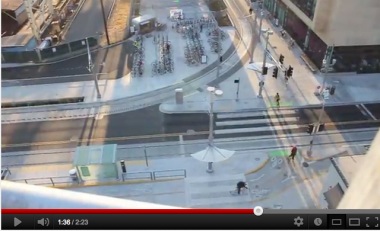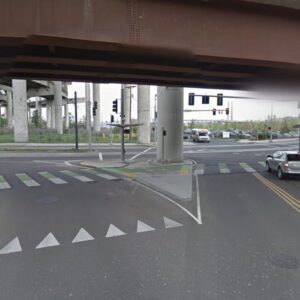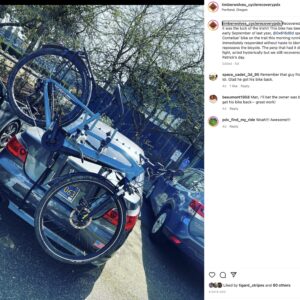
picture in South Waterfront.
(Video still – Watch video below)
Our friend (and BTA Alice Award winner, Bike Train superstar and bike shop entrepreneur) Kiel Johnson is a close observer of how people are getting around in the South Waterfront area near the tram and OHSU.
Kiel runs the Go By Bike bike shop and valet service and he’s seen first-hand how the cycle-track on SW Moody, the aerial tram, the streetcar, and the new Gibbs Street Bridge have changed the area. He recently made a film highlighting the intersection where all these things come together. It’s an amazing look at what can happen when a city invests (a lot)* into giving people choices. It’s a multi-modal dreamworld. It reminds me of those YouTube videos of intersections in the early 1900s where it looks crazy and busy; but somehow, it works.
Watch it below…
What’s going on near Kiel’s shop in South Waterfront is the closest thing to European conditions that exists in America. The South Waterfront is like a transportation petri dish where politicians are funding the research and urban planners are the scientists. So far, the experiment seems to be working. Yes, it took a lot of money and political capital to make it happen; but it’s proof that we can do this in America.
But after your buzz from watching the video wears off… Remember this is just one intersection out of 22,000 in Portland. It’s one tiny slice that simultaneously shows how far we’ve come and how far we still have to go.
— Read more about the video and the cool stuff happening in South Waterfront in this blog post on the Green Lane Project website.
*Investing a lot of money isn’t the only way to give people choices and create scenes like this. We could quickly and cheaply create thriving intersections like this one all over the city if we made our public space favor people and not private automobiles.






Thanks for reading.
BikePortland has served this community with independent community journalism since 2005. We rely on subscriptions from readers like you to survive. Your financial support is vital in keeping this valuable resource alive and well.
Please subscribe today to strengthen and expand our work.
How did they get this intersection so right, and the one just north of it (the bike signal under the Marquam Bridge) so wrong?
TriMet will actually be extending the cycle track north of where it now ends at Sheridan Street as part of their light rail construction. The new bike path will be below the elevated light rail tracks just west of the sub station (the former Willamette Shore Trolley right-of-way). The bike path will then cross River Parkway and end at Harbor Way next to the Riverplace Athletic Club. PBOT has added sharrows to Harbor Way in anticipation of the new path.
Anyway, once the bike path opens fewer bicyclist will need to cross Moody a second time at Sheridan Street as most will choose to continue northbound on the new path.
Hate to say that its not quite right. Just to the right (south) there is a day care and bus stop where it gets quite dangerous for bikes coming down onto the roadway from that intersection. As someone who travels through there every day I see lots of cyclists almost get doored or run into along that southern stretch. I must admit it is much nicer than what was there before and what is available in other locations. Be careful out there.
I have to agree, ride through this area several times a week and have nearly been doored multiply times and have many cars that just part or hang out in the bike lane. With the tracks just to the left of the bike lane, it’s a dangerous move to have to avoid them.
Also I’d like to hear more about the best way to enforce or protect the cyclepath on Moody for bike and have the peds use the pedestrian lane. I think it’s pretty well marked where to go, but everytime I ride on the path seems that I have to avoid or let peds know they aren’t in the proper lane.
Lastly, on the Marquam bridge intersection, I think it’s ok, but find that the southbound section that forces you to go around the pillar to be very dangerous as it is blind and as I stated many peds walk there. I’ve nearly had more than one collision with peds hanging out behind the pillar. This is something that needs to be addressed. A sign might be a good start.
As far as multimodal planning, on Moody south of Whitaker, they blew it.
As it’s designed now, parked cars have no room at all to park shy of the bike lane. The bike lane IS the door zone. And there’s no escape but the kill zone of the streetcar and its rails.
Google Streets Image
It seems ridiculous to be in this situation and have to say this after all the work has been done, but I think that the city needs to prohibit all of the curbside auto parking along the west side of Moody south of Whitaker.
On NE 7th Ave, the city and the Streetcar project allocated virtually the same cross-section of space completely for the bike lane and for riding shy of the streetcar and its rails, with no room for auto parking:
Google Streets Image
It seems that this design is somewhat temporary. If you notice, the sidewalk has been put in with asphalt, not the more permanent and standard concrete. Are there imminent plans to develop this property, which would allow a wider parking area and reduce the dooring issue?
Agreed! Daycare drop-offs next to the bike lane, which is next to streetcar tracks…this is a spot where I am extra careful.
On the plus side, the intersection Jonathan’s describing is the culmination of tens of million in infrastructure and years of planning. The problem for through commuters headed south comes down to a few gallons of paint. I’d suggest the City consider changing the layout from a bike lane to in-street sharrows on the passing lane. As noted, there’s a daycare right there and no one should be driving faster than a bike moving at a casual pace. In the meantime, you can always take the lane and argue it was a safety necessity if anyone asks (I seriously doubt anyone will).
Taking the passing lane still involves crossing the streetcar tracks, which is pretty hard to do at a 90 degree angle in the space allotted. Any good ideas for how to get from the cycle track to the passing lane safely, John? This is a real call, I will totally use your secret trick if you divulge it 🙂
Hmm. Good point. You could take the slow, careful strategy by accessing the left lane from the Moody & Gibbs intersection when the light is green for bikes. Or you could ride the center of the streetcar lane through all of Moody (which makes the cycle track not of use to you but lets you move as fast as you please).
OK – slow careful strategy it is. I’m on a Dutch bike after all so I’m not going anywhere fast anyway 🙂
it’s nice to see people moving so fluidly interspersed with a few cars…
the peds and bikes aren’t always obeying the crosswalk signal and it doesn’t seem to effect anything…
I have to say, this particular intersection is super-awesome. Thanks for highlighting it, Kiel!
I also have to agree with Peter O. that there are significant issues remaining in the immediate area. For example, just to the south of this intersection (to the right of the screenshot shown) the cycle track going southbound turns into a door-zone bike lane with streetcar tracks making any escape from the door zone hazardous.
Density. Good urban design is driven by density.
There is no way this level of investment would be justified or successful if we didn’t have giant residential towers and a major employer in the immediate vicinity.
It’s a fine model to strive for, and at the BTA we do every day, but our challenges throughout the city are different due in large measure to the differences in our urban fabric.
This says to me that all bike advocates should be smart growth advocates too.
“This says to me that all bike advocates should be smart growth advocates too.”
Let’s not forget that the spectrum doesn’t just reach from dumb growth to smart growth. How about advocating no-growth?
Sure, we know ‘it’s coming,’ ‘everyone wants to move here,’ Interstate Commerce Clause,’ etc., but that doesn’t mean we can’t also include, recall, insist that growth is not the only, much lest the best way to do things.
We don’t control regulations everywhere. No-growth in Portland means huge growth in Battle Ground, Helvetia, and Damascus. Is that really what you want?
This does not have to be a zero-sum game. Doing nothing because of the potential for spillover you’re talking about, is a lame excuse.This is not leadership, forward thinking, bold – the things Portland and Oregon are known for. We already have an urban growth boundary, so why not elaborate on the concept, encourage the conversation to include these larger issues.
A nifty organization did just this a few years back – Alternatives to Growth Oregon: http://www.agoregon.org/
If you want to go ahead with that kind of policy, start with Clark County, WA. They have nothing near the strength of urban growth boundary we have.
In my view, I’m simply accommodating the reality that global population is growing, US population is growing, populations everywhere are urbanizing, and some of those add’l urban people have decided they want to live in the Portland metro area. Getting them to decide to live elsewhere would involve IMO draconian measures. Not letting new developments be built means that existing developments become that much more valuable (and expensive). Do you really want real estate prices to go to San Francisco or Vancouver, BC levels? Because that’s the direct result of limiting development. Supply and demand.
“Supply and demand.”
We’re drifting here, but it is Not That Simple. If you build or expand a freeway we know that what happens next is called induced demand. Why should it necessarily be so different for other activities we engage in when we accommodate anticipated growth? What do we gain by restricting the conversation, forbidding discussion of the no-growth option? Sticking with the infrastructure analogy that would be like saying ‘since we’re going to have to double our road capacity in the next fifty years which is it going to be – freeways or intelligent highways? Surely we can handle divergent views, perspectives that don’t share the premise that the only way forward is to keep doing what we’ve always done.
When do we get to enough?
Very cool.
I wonder though about the ‘a lot of money’ part. Are there ways to achieve something like this without a lot of money? Is the money what makes this work? Or the relative absence of cars? Or good design? Or something else entirely?
Given that we don’t seem to have (or appropriate) much money for this sort of thing, generally, are there lessons here that could be applied to other less well funded intersections or streets? Or do we just need to keep the cars out?
Speaking of vintage street scenes, this is my favorite:
http://www.archive.org/details/TripDown1905
Glad you brought that up 9watts.
I absolutely don’t think a lot of money is the only way to do this. Absent the Tram and the Streetcar of course, which are very expensive… We could easily do this by re-allocating public space and using is more for humans instead of private automobiles. If we put humans first instead of cars, we could quickly and cheaply retrofit the entire city.
This stretch of the Moody Cycle track is awesome where it is slightly depressed from the sidewalk, the part to the north is disappointing and confusing to all, it reads as a shared promenade and the trees separating the two directions of cycle track are illogical, the trees should separate the bike zone from the ped zone. The whole length of the Moody Cycle Track should be like the portion by Gibbs.
I have a handful of friends who work at OHSU, some who swore they would never bike commute but now do. Besides the awesome infrastructure and investments we’ve made for active transportation here, a huge incentive for folks to not drive to work and utilize this intersection by other modes is how difficult it is to park at OHSU.
OHSU doesn’t bend over backwards to provide car parking for staff and has clearly embraced the answer to the problem: encourage staff walk, bike or take transit to work. And heck, they save so much money but not providing all that extra parking space, they can pay them to do so.
Looking forward to more employers embracing this approach.
Here’s two fun facts to consider: 1.) OHSU actually does offer car valet (same price as non-valet parking–so it could be considered “free”) in some areas including one block from the bike valet. 2.) In the same area, OHSU has two day parking zones for cars that never sell out and relatively (relatively) short wait lists for long term permits. The conclusion I draw is that OHSU is making reasonable accommodations for driving but when other modes become attractive enough, people simply choose not to.
Smart call on the lower case “city.” City of Portland has done some great work but this is a true example of a community coming together. Huge investments by OHSU, PBOT, Obama’s stimulus package, South Waterfront developers, the TMA and others were essential to making this happen. The people utilizing the space as their gateway to work and school make it successful.
its just a matter of time before someone is seriously injured by the blind corner under the marquam bridge. seriously bad design. and i won’t even rant about the criss crossing.
I would love to see an advance story on how the max is going to cross the cycle track and how cyclists coming off the bridge are going to integrate into the traffic flow.
Its going over the top. You can see its path pretty clearly now.
Actually, the new MAX line will cross Moody Ave and the cycle track at grade. Once the rail line gets west of Moody it begins the climb on the Harbor structure up to Naito.
Oh that sucks. I was told it was going over the top earlier but that makes some of the recent work down there make a little more sense. yay! more tracks to cross.
The key lesson here is that multiple modes with lots of people work quite well…because everyone slows down and keeps an eye out. (Actually J-walking is the safest way to cross a street.) MAX and the Willamette Greenway Trail still to come..should get even more interesting.
Meanwhile at your back is a loud, polluting piece of infrastructure designed to allow people in deadly motorized devices to go 60 mph thru the middle of the city. Now that is insane.
Awesome. I ride through here often and it is great. I need to call about parking enforcement on the west side of Moody just past the intersection going South. There are often cars parked in the bike lane which pushes me too close for comfort to the light rail tracks. The interestion and cycle track rock.
What an interesting perspective!
I ride Moody every day, and it’s a great path, but probably amongst the most disregarded bike area for following rules in the city!
– The lights are far too long at the north end of the path. Easily 3+ minute wait for light rail and three other directions. Easier just to stay on the sidewalk than cross back over to East side of Moody.
– The lights crossing Moody at South end take too long to allow bike traffic. Most bikers just go anyway.
– HORRIBLE waterfront access South of Moody, not to mention the awkward hookup to the Waterfront path North of Moody.
Inconsistency all around this city. Very much evidence for better planning needed.
What works? All the space bikers get on Moody itself.
Wow, someone must have spent a lot of time carefully editing that time-lapse footage to make it seem like this intersection is anything but dangerous chaos. After almost being hit by a car running that particular red light at about 40 MPH yesterday morning on my way into work, the title of this article popped into my head AGAIN.
I’ve been bike commuting to the Tram for a few years now, and I DO think that the recent renovations have made biking Moody safer on the whole, but I also think that the planning was just a little underthought. First of all, I worry (every day, in fact) that the setup for the bike-crosswalk-button on that bend makes it look like bikes are playing chicken with cars. Additionally, while the extremely short wait for the bike light to turn green is nice, I would rather if that southbound yellow light were longer because I’ve seen both cars AND buses blow through reds there, and I think it’s in part because the light changes too quickly. Finally, notice how the bike crossing is to the south of the pedestrian-specific crosswalk, yet the bike parking is north of the pedestrian crosswalk, meaning that probably half of the bikes/pedestrians coming through have to then cross through each other – next to streetcar tracks. Simple flaws. Everyday hassle and danger.